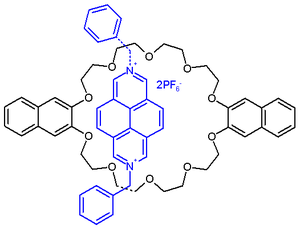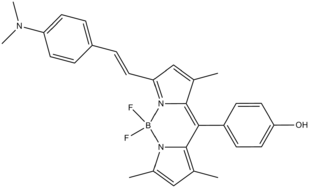Molecular logic gate
A molecular logic gate is a molecule that performs logical operations based on one or more physical or chemical inputs and a single output. The field has expanded from a simple logical system based on a single chemical or physical input to molecules capable of combinatorial or sequential operations such as arithmetic operations and memory storage algorithms.
Basic principle of a logic gate with AND logic
There are four possible output patterns for logic gates with a single output. If the input is 0, the output can either be 0 or 1. If the input is 1, the output can again be 0 or 1. The four output bit patterns that can arise belong to a certain type of logic: PASS 0, YES, NOT and PASS 1. PASS 0 always results in output 0, regardless of the input. YES outputs a 1 if the input is 1, and NOT is the reverse of YES - the output is 0 if the input is 1. An example of a YES logic gate is the structure shown below. A 1 output is given when there are sodium ions in the solution (that means 1 input).
Molecular logic gates respond to input signals that are based on chemical processes with output signals that are based on spectroscopy . One of the first water-based systems shows the chemical behavior of compounds A and B in Scheme 1.
Compound A is a push-pull olefin with a receptor that contains four carboxy groups that are able to bind calcium ions. The lower part is a quinoline molecule, which is a receptor for hydrogen ions. The logic gate works as follows: Without a chemical input of Ca 2+ or H + , the chromophore shows an absorption maximum at 390 nm in the UV / VIS spectrum. If calcium ions are added, there is a blue shift and the absorption at 390 nm disappears. Similarly, the addition of protons (hydrogen ions) causes a redshift ( bathochromism ), and when both ions are present, the absorption appears again at 390 nm. This system is an example of an XNOR logic gate for absorption and an XOR logic gate for permeability .
In compound B, the lower part contains a tertiary amino group that can also bind protons. In this system, fluorescence occurs in the presence of both types of ions. The presence of both cations prevents photoelectron transfer (PET), which enables compound B to fluoresce. In the absence of either or both of the ions, the fluorescence is quenched through PET, which means that electron transfer from nitrogen - or oxygen atom or two to anthracenyl takes place. As soon as both receptors are bound to calcium ions and protons, both PET channels are closed. The overall result is that there is an AND logic for compound B, since the output of 1 (fluorescence) appears when both cations, Ca 2+ and H + are present in the solution (value 1). If both systems run in parallel and one considers the transmittance for system A and the fluorescence for system B, one is able to reproduce the equation 1 + 1 = 2.
Logic gate with multiple inputs
In a variant of system B, not two but three chemical inputs are carried out simultaneously in an AND logic gate. An extended fluorescence signal is only observed in the presence of an excess of protons, zinc and sodium ions, based on interactions with amine, phenyldiaminocarboxylate and crown ether receptors. The procedure is similar to that discussed above: fluorescence is observed as soon as the interfering photoelectron transfer between the receptor and the anthracene fluorophore is blocked. The absence of one, two or all three ions results in a low fluorescence output. Each receptor is selective for a specific ion and increasing the concentration of the other ions does not lead to higher fluorescence. The specific concentration of each individual input is achieved by having a fluorescence output in coordination with a combinatorial AND logic. This prototype can possibly be extended for an application in medical diagnostics in the screening of diseases.
In a similar setup, a logic gate is shown below, which documents the development from a redox- fluorescent switch to a multi-input logic gate with an electrochemical switch. This two-input AND logic gate consists of a tertiary amine as a proton receptor and a tetrathiafulvene redox donor. These groups, linked to an antracen, can simultaneously provide information regarding the acid concentration and the oxidation strength of a solution in one process.
INHIBIT logic gate
The INHIBIT logic gate shown below, as used by Gunnlaugsson et al. contains a Tb 3+ ion in a chelate complex . This two-input logic gate is the first of its kind and shows the non- commutative behavior with chemical input and a phosphorescence output. If oxygen is present (input 1), the system's phosphorescence is extinguished (output 0). The second input: If protons are present, output 1 is observed. This is what we mean by a two-input INHIBIT truth table .
, The INHIBIT logic gate is shown in Scheme 3. In organic solution the electron-deficient form pyrrole / diazapyrenium salt and the electron-rich 2,3-dioxynaphthalene units of a crown ether rings, the overall molecular structure (so-called. Molecular self-assembly ) by forming a charge-transfer complex .
An added tertiary amine such as tributylamine forms a 1: 2 adduct with diazapyrrole and the complex is dethreaded. This process is accompanied by an increase in the emission intensity at 343 nm, which results from the free crown ether. Added trifluoromethanesulfonic acid reacts with the amine and the process is reversed. Excess acid closes the crown ether by protonation and the complex is dethreaded again.
A system based on fluorescein is able to calculate 1 + 1 + 1 = 3.
Applications of logic gates
As an electronic lock
D. Margulies gives an example of sequential logic by showing a molecular combination lock which, in its applicability for electronic security, is the equivalent of various AND logic gates connected in parallel. The molecule copies an electronic lock on an ATM. The output signals depend not only on the combination of the inputs, but also on the correct order of the inputs: In other words, the correct password must be entered. The molecule was developed with pyrrole and fluorescein units linked by a side chain that can bind Fe (III), and in acidic solution the fluorescein properties of the fluorescein fluorophore change.
As a semiconductor replacement
With a further development in this field of work, molecular logic gates could replace semiconductors in the IT industry. These molecular systems could, for example, solve the problems if semiconductors in the molecular nanoscale are needed. Molecular logic gates are more universally applicable than their silicon analogues, with phenomena like superordinate logic that cannot be achieved in semiconductor electronics. Solid-state molecular logic gates such as the one shown by Avouris prove that it is possible to replace semiconductors because of their small size, similar infrastructure, and good data processing capabilities. Avouris implemented a NOT logic gate that consists of a bundle of nanotubes . The nanowires were changed differently in the boundary layers and thus created two transistors with opposite fields. The bundle works as a NOT logic gate under very specific conditions.
In photodynamic therapy
New ways of using chemical logic gates have yet to be explored. A recent study shows the application of logic gates in photodynamic therapy . A dye linked to a crown ether and two pyridyl units via a bridging molecule (as shown below) works according to an AND logic gate. The molecule works as a photodynamic reagent when irradiated with 660 nm light under conditions of a relatively high salt concentration and high acid strength by converting triplet oxygen into cell-toxic singlet oxygen . This prototype would take advantage of the increased salt concentration and low pH value in tumor cells compared to normal cells. When these two cancer cell characteristics are given, a change in the absorption spectrum is observed. This technique could be useful for treating malignant tumors.
Subtractive logic gates
A molecular logic gate can switch between different processes as with de Silva, it contains different logic gates on the same molecule. Such a function is called integrated logic and can be seen in the example of the BODIPY-based, semi-subtractive logic gate by A. Coskun, EU Akkaya and their colleagues. When measuring two different wavelengths, 565 nm and 660 nm, one obtains XOR and INHIBIT logic gates of the corresponding wavelengths. Optical measurements of this compound in THF show an absorption peak at 565 nm and an absorption peak at 660 nm. The addition of an acid causes a hypsochromic shift and both peaks are based on an internal charge transfer (ICT) when the tertiary amine is protonated. The color of the observed emission is yellow. When a strong base is added, the phenolic hydroxyl group is deprotonated, followed by photo-induced electron transfer (PET), which quenches the molecule's emission. When both acid and base are added, a red emission of the molecule is observed, since the tertiary amine is not protonated, but the hydroxyl group is, whereby both PET and ICT are absent. Because of the large difference in the intensity of the emission peaks, a single molecule will be able to perform an arithmetic operation, that is, a subtraction on a nanoscale level.
Web links
- A Molecular Photoionic AND Gate Based on Fluorescent Signaling
- The 3rd International Conference on Molecular Sensors & Molecular Logic Gates (MSMLG) was held on July 8-11, 2012 at Korea University in Seoul, Korea. ( Memento from May 3, 2013 in the web archive archive.today )
Individual evidence
- ↑ A. Prasanna de Silva and Nathan D. McClenaghan. Proof-of-Principle of Molecular-Scale Arithmetic J. Am. Chem. Soc. 2000 , 122, 16, 3965-3966. doi : 10.1021 / ja994080m
- ↑ David C. Magri, Gareth J. Brown, Gareth D. McClean and A. Prasanna de Silva. Communicating Chemical Congregation: A Molecular AND Logic Gate with Three Chemical Inputs as a "Lab-on-a-Molecule" Prototype J. Am. Chem. Soc. 2006 , 128, 4950-4951. (Communication) doi : 10.1021 / ja058295 +
- ↑ David C. Magri. A fluorescent AND logic gate driven by electrons and protons. New J. Chem. 2009 , 33 , 457-461.
- ↑ T. Gunnlaugsson, DA MacDonail and D. Parker, Chem. Commun. 2000 , 93.
- ^ Alberto Credi, Vincenzo Balzani , Steven J. Langford, and J. Fraser Stoddart . Logic Operations at the Molecular Level. An XOR Gate Based on a Molecular Machine J. Am. Chem. Soc. 1997 , 119, 2679-2681. doi : 10.1021 / ja963572l
- ↑ David Margulies, Galina Melman, and Abraham Shanzer. A Molecular Full-Adder and Full-Subtractor, an Additional Step toward a Moleculator J. Am. Chem. Soc. 2006 , 128, 4865-4871. doi : 10.1021 / ja058564w
- ↑ David Margulies, Galina Melman, and Abraham Shanzer. A molecular keypad lock: A photochemical device capable of authorizing password entries. J. Am. Chem. Soc. 2007 , 129 , 347-354.
- ↑ S. Oslem and EU Akkaya. Thinking outside the silicon box: molecular AND logic as an additional layer of selectivity in singlet oxygen generation for photodynamic therapy. J. Am. Chem. Soc. 2009 , 131 , 48-49.
- ^ A. Coskun, E. Deniz and EU Akkaya. Effective PET and ICT switching of boradiazaindacene emission: A unimolecular, emission-mode, molecular half-subtractor with reconfigurable logic gates . Org. Lett. 2005 5187-5189.






